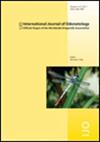Community assembly of adult odonates in lacustrine systems of an understudied world heritage site of south-eastern Zimbabwe
IF 1
4区 农林科学
Q3 ENTOMOLOGY
引用次数: 0
Abstract
Odonata (dragonflies and damselflies) are efficacious for management and conservation efforts in freshwaters. In recent times, increased effort has gone into enhancing awareness, data and information on dragonflies among scientists and policymakers. Here, we examined the Odonata community of dams within the Matobo National Park, a world heritage site in southern Zimbabwe. Specifically, we determined diversity of larval and adult odonate in five dams over one year. Several physico-chemical parameters were measured, including pH, total dissolved salts (TDS), electrical conductivity (EC). Further, we assessed how habitat types (i.e., detritus, sand, gravel, plant type) affect Odonata communities. In addition, surveys were conducted to identify critical threats to Odonata in the Matobo National Park and surrounding areas. Broadly, results showed that Odonata nymphs and volant adults did not change predictably across all sampling occasions. Further, pH was positively correlated with Libellulidae and Platycnemididae, whereas TDS and EC were positively correlated with Libellulidae, Platycnemididae and Macromiidae. Contrariwise, Gomphidae were found to be negatively correlated to TDS, EC and pH. The threat analyses identified natural system modifications, agricultural expansion and intensification, as well as human intrusions and disturbance as the major threats to Odonata and freshwater resources in Matobo National Park. Taken together, these data provide baseline data that will be useful for future monitoring of threats and subsequently conservation strategies in the Matobo National Park and other protected areas in Southern Africa.津巴布韦东南部一个未被充分研究的世界遗产地湖泊系统中成年齿蛙的群落聚集
蜻蜓(蜻蜓和豆娘)对淡水的管理和保护工作是有效的。近年来,科学家和政策制定者在加强对蜻蜓的认识、数据和信息方面付出了越来越多的努力。在这里,我们考察了津巴布韦南部世界遗产马托博国家公园内的奥多纳塔水坝群落。具体地说,我们在一年内测定了5个水坝的幼虫和成虫的多样性。测量了几种理化参数,包括pH、总溶解盐(TDS)、电导率(EC)。此外,我们还评估了生境类型(即碎屑、沙子、砾石、植物类型)对蛇齿目动物群落的影响。此外,还进行了调查,以确定马托博国家公园及周边地区对大腹蛇的严重威胁。总的来说,结果表明,在所有的采样场合,蜻蜓若虫和飘动的成虫并没有发生可预测的变化。pH值与利贝科、扁贝科呈显著正相关,TDS和EC与利贝科、扁贝科和巨贝科呈显著正相关。Gomphidae与TDS、EC和ph呈负相关。自然系统的改变、农业的扩张和集约化以及人为入侵和干扰是对Matobo国家公园Odonata和淡水资源的主要威胁。综合起来,这些数据提供了基线数据,这些数据将对未来监测马托博国家公园和南部非洲其他保护区的威胁和随后的保护战略有用。
本文章由计算机程序翻译,如有差异,请以英文原文为准。
求助全文
约1分钟内获得全文
求助全文
来源期刊

International Journal of Odonatology
ENTOMOLOGY-
CiteScore
2.30
自引率
0.00%
发文量
15
审稿时长
>12 weeks
期刊介绍:
International Journal of Odonatology (IJO) is aimed at providing a publication outlet for the growing number of students of Odonata. It will address subjects such as the ecology, ethology, physiology, genetics, taxonomy, phylogeny and geographic distribution of species. Reviews will be by invitation, but authors who plan to write a review on a subject of interest to the journal are encouraged to contact the editor.
 求助内容:
求助内容: 应助结果提醒方式:
应助结果提醒方式:


